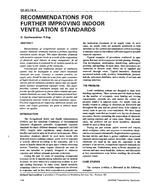Description
States that measurements of occupational exposure to volatile organic chemicals commonly indicate a problem with ventilation system design. Describes situations with excessive exposure levels as a result of the evaporation of chemicals used indoors in many occupations. In all cases, evaporation is promoted by air motion caused by air supply vents in the vicinity of the chemicals. Notes that conventional and traditional designs of ventilation systems may be inadequate in areas where hazardous chemicals are used. Contrary to common practice, air supply vents should be kept away from open containers of liquid chemicals to minimise the rate of evaporation. Air velocity and air turbulence promote vapours and can significantly increase occupational exposure levels. Describes common ventilation designs and the need to provide specific guidance in places where volatile and semi-volatile chemicals are used. States the information presented is based on actual measurements of indoor air quality and occupational exposure levels to various hazardous vapours. Provides practical suggestions for improving ventilation systems and gives simple guidelines to achieve better indoor air quality.
KEYWORDS: Ventilation, contaminants, health, hazards, organic compounds, evaporation, designing, air movement.
Citation: Symposium, ASHRAE Trans., 1993, vol.99, part 2, paper number DE-93-1-1, 429-439, 7 figs, 2 tabs, refs.
Product Details
- Published:
- 1993
- File Size:
- 1 file , 710 KB
- Product Code(s):
- D-17577




